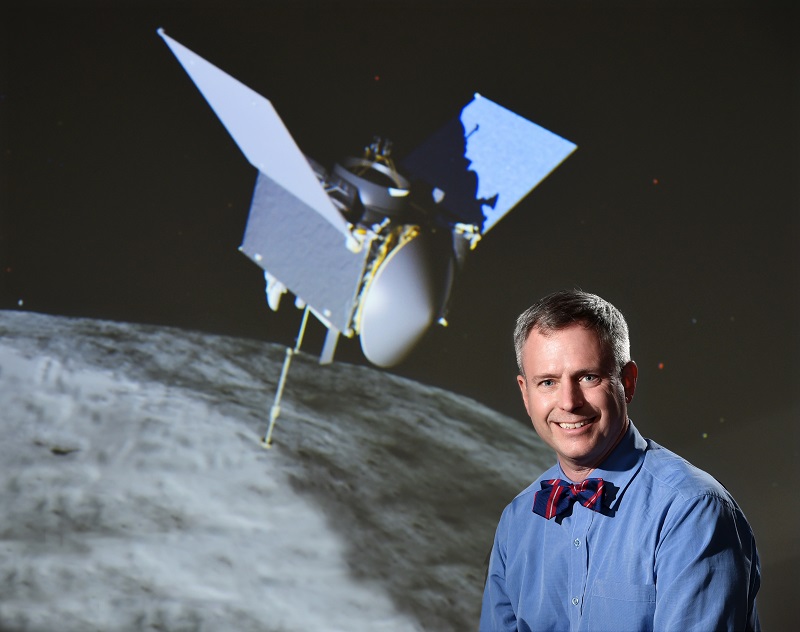Studying Bennu: Rowan geologist to lead scientific study of asteroid samples from NASA mission
Studying Bennu: Rowan geologist to lead scientific study of asteroid samples from NASA mission

The first-ever NASA mission to collect an asteroid sample and return it to Earth for analysis launches on Thursday, Sept. 8, at 7:05 p.m. from the Kennedy Space Center in Cape Canaveral, Fla.
Geologist and petrologist Harold C. Connolly, Jr., the mission sample scientist, can hardly contain his excitement.
“I have one of the best jobs in the whole mission,” Connolly says of OSIRIS-REx, the $1 billion mission designed to help scientists understand the early solar system by taking samples from the asteroid Bennu. “There isn’t a day that goes by that I don’t think about that asteroid a dozen times.”
Connolly joined Rowan University on Sept. 6 as the founding chair and professor of the Department of Geology in the new School of Earth & Environment. Involved with OSIRIS-REx (Origins, Spectral Interpretation, Resource Identification, Security-Regolith Explorer) since 2008, the self-described “explorer of space and time” will lead scientists in the study of up to two kilograms (4.4 pounds) of a “pristine, carbon-rich” sample from the asteroid.
Asteroids are the “leftover debris” from the Solar System’s formation formed more than 4.5 billion years ago. Analyzing the Bennu sample—“We’re collecting pebbles down to sand grains,” Connolly says— “will revolutionize our understanding of the early Solar System and teach us much about the planetary history and the origin of life,” according to NASA. It also will help scientists understand the “hazards and resources of near-Earth space,” NASA officials note.
“One of the missions of OSIRIS-REx is to look for pre-biotic compounds—compounds which could have led to the origin of life on earth and, also, potentially how water was delivered on Earth,” Connolly says.
“To me, the ultimate question is: How did the planet form?’” continues Connolly.
He adds that OSIRIS-REx also will help scientists better understand the movement of asteroids, which can fall to Earth.
“One of the goals of OSIRIS-REx is to look at security of the planet,” he says. “Asteroids have a tendency to hit Earth. Part of the problem with that is predicting their movement. In order to do that accurately, we need to know the composition of asteroids.”
In addition to his work with OSIRIS-REx, Connolly also is co-investigator of the Hayabusa2 asteroid sample with the sample analysis team at Hokkaido Univeristy, led by Professor Shoto Tachibana. Connolly was a visiting professor at the university last year.
Thus, Connolly, whose fascination with rocks began at age five—“They’re the ultimate preservers of time, the ultimate fossils,” he says--holds critical leadership positions in two international asteroid exploration missions that are working together to learn more about the Earth’s origin. It’s the first time two governments throughout the world have operated two asteroid missions simultaneously, according to Connolly.
Nine-year timeline for OSIRIS-REx
From launch to analysis completion, the OSIRIS-REx mission will take nine years, wrapping up in 2025. The mission’s Atlas V 411 rocket will have a 34-day launch period beginning Sept. 8 and will orbit the sun for a year. In August of 2018, it will begin its approach to Bennu.
It will take another year as potential sample sites are determined. Connolly plays a vital role in determining where the sample site on the asteroid, which is about the size of a football field. He’ll work with NASA engineers to determine the best location for both “samplability” and science value.
“My team gets to recommend a sample collection site based on what has the greatest science value. It’s totally awesome. I will be in constant contact with the mission,” Connolly says.
Once the site is determined, an arm of the rocket will collect the sampler. In what Connolly likens to a “space vacuum cleaner,” the sampling arm will emit nitrogen gas, which will allow the sample to be gathered. That process will take five seconds. The sampling arm can accommodate three attempts to collect the minerals.
OSIRIS-REx will begin its journey back to Earth in March of 2021, a process that will take another two years. Once the spacecraft enters the atmosphere in the Utah desert in September of 2023, Connolly and his team of scientists will begin its research, which will be two more years.
“Exploring takes a lot of time, a lot of patience, and a lot of hard work,” says Connolly. “But the rewards are incredible.”
View Connolly’s presentation on OSIRIS-REx on the American Museum of Natural History’s Facebook page: https://www.facebook.com/naturalhistory/?fref=ts.
About Harold Connolly
A research associate at the American Museum of Natural History in New York City and an adjunct associate professor of planetary sciences at the Lunar and Planetary Laboratory at the University of Arizona, Connolly joined the Department of Physical Sciences as an assistant professor of Earth and Planetary Sciences at Kingsborough Community College of the City University of New York in 2001.
In Rowan’s School of Earth & Environment, he will work with Founding Dean Ken Lacovara, an internationally known paleontologist and director of the Rowan Fossil Park, to develop bachelor’s, master’s and doctoral programs in geology.
Connolly earned his bachelor’s degree, master’s degree and doctorate in geological science from Rutgers University.
Connolly grew up in South Jersey. He lived primarily in Barrington and attended high school in both Haddon Heights and Washington Township, graduating from Heights in 1983.
And he has an asteroid named after him.
“My obituary can say I’m survived by an asteroid,” he chuckles.